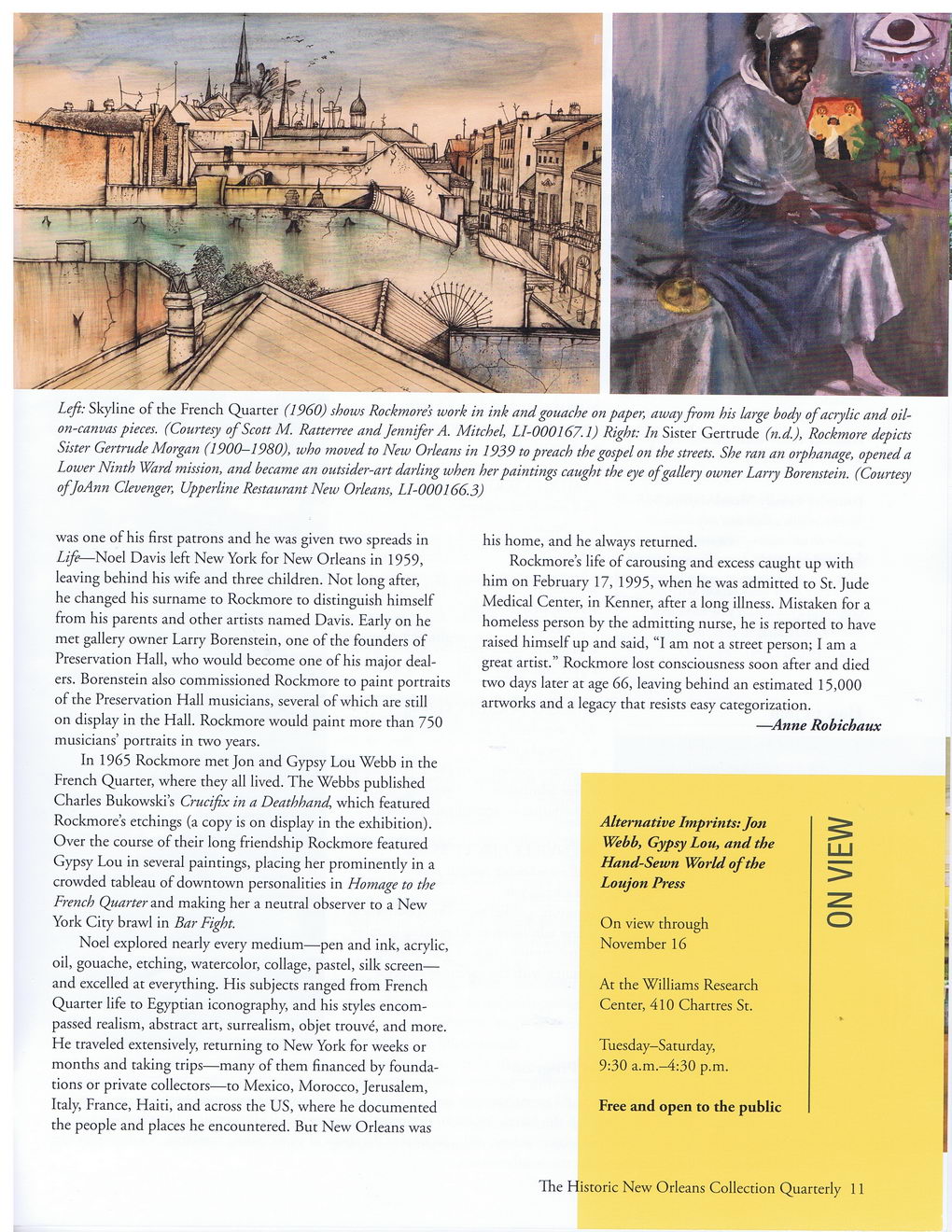This text was obtained via automated optical character recognition.
It has not been edited and may therefore contain several errors.
Left: Skyline of the French Quarter (1960) shows Rockmore’s work in ink and gouache on paper, away from his large body of acrylic and oil-on-canvas pieces. (Courtesy ofScott M. Ratterree and Jennifer A. Mitchel, LI-000167.1) Right: In Sister Gertrude (n.d,.), Rockmore depicts Sister Gertrude Morgan (1900—1980), who moved to New Orleans in 1939 to preach the gospel on the streets. She ran an orphanage, opened a Lower Ninth Ward mission, and became an outsider-art darling when her paintings caught the eye of gallery owner Larry Borenstein. (Courtesy ofJoAnn Clevenger, Upperline Restaurant New Orleans, LI-000166.3) was one of his first patrons and he was given two spreads in Life—Noel Davis left New York for New Orleans in 1959, leaving behind his wife and three children. Not long after, he changed his surname to Rockmore to distinguish himself from his parents and other artists named Davis. Early on he met gallery owner Larry Borenstein, one of the founders of Preservation Hall, who would become one of his major dealers. Borenstein also commissioned Rockmore to paint portraits of the Preservation Hall musicians, several of which are still on display in the Hall. Rockmore would paint more than 750 musicians’ portraits in two years. In 1965 Rockmore met Jon and Gypsy Lou Webb in the French Quarter, where they all lived. The Webbs published Charles Bukowski’s Crucifix in a Deathhand, which featured Rockmore’s etchings (a copy is on display in the exhibition). Over the course of their long friendship Rockmore featured Gypsy Lou in several paintings, placing her prominently in a crowded tableau of downtown personalities in Homage to the French Quarter and making her a neutral observer to a New York City brawl in Bar Fight. Noel explored nearly every medium—pen and ink, acrylic, oil, gouache, etching, watercolor, collage, pastel, silk screen— and excelled at everything. His subjects ranged from French Quarter life to Egyptian iconography, and his styles encompassed realism, abstract art, surrealism, objet trouve, and more. He traveled extensively, returning to New York for weeks or months and taking trips—many of them financed by foundations or private collectors—to Mexico, Morocco, Jerusalem, Italy, France, Haiti, and across the US, where he documented the people and places he encountered. But New Orleans was his home, and he always returned. Rockmore’s life of carousing and excess caught up with him on February 17, 1995, when he was admitted to St. Jude Medical Center, in Kenner, after a long illness. Mistaken for a homeless person by the admitting nurse, he is reported to have raised himself up and said, “I am not a street person; I am a great artist.” Rockmore lost consciousness soon after and died two days later at age 66, leaving behind an estimated 15,000 artworks and a legacy that resists easy categorization. —Anne Robichaux Alternative Imprints: Jon Webb, Gypsy Lou, and the Hand-Sewn World of the Loujon Press On view through November 16 At the Williams Research Center, 410 Chartres St. Tuesday-Saturday, 9:30 a.m.—4:30 p.m. Free and open to the public LU The Historic New Orleans Collection Quarterly 11

New Orleans Quarterly 2013 Fall (11)